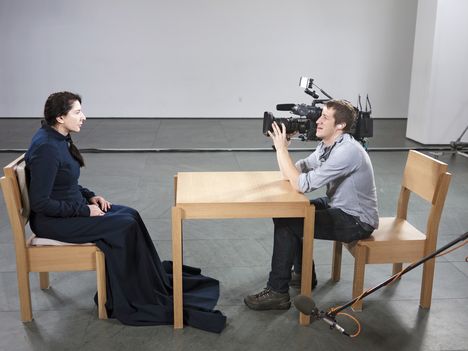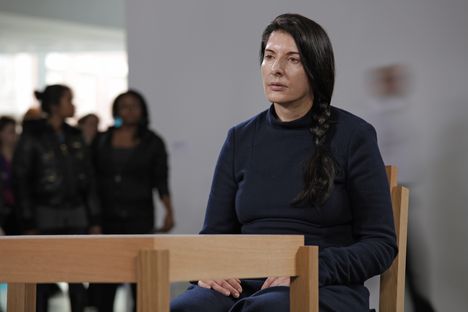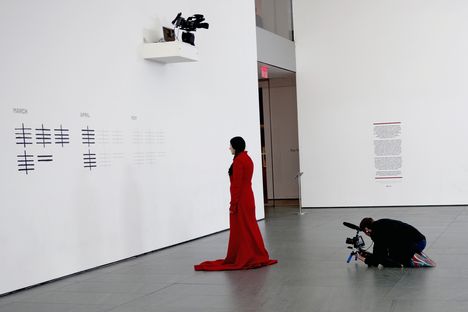At the Present Time: Matthew Akers on 'Marina Abramovic'
In the most powerful moment of Matthew Akers' Marina Abramovic: The Artist Is Present, a kid walks away from a sitting with performance artist Marina Abramovic and looks traumatized. Frightened, his mother asks, "What's wrong!?" and when she realizes he just had a transformative experience, she begins to cry. It's pride she's showing, and it scares her son out of his momentary, possibly transcendental stupor. Should he have been protected from all that? Is that a reasonable question?
On the list of credible professions, "performance artist" ranks just beneath "ponzi schemer" and "tent revival minister," and that's part of director Matthew Akers' agenda bringing the work of Marina Abramovic to screen.
As part of a massive retrospective launched by the Museum of Modern Art in New York City in 2011, Abramovic hired a few dozen up-and-coming artists to act as surrogates of her in restagings of her previous works so she could be in the centerpiece-"The Artist Is Present." As if she's absorbing and denouncing suggestions of her own fraudulence, Abramovic sat in the MOMA space to lead guests in something as much a mystery to her as to onlookers.
How do you represent that? Matthew Akers suggests, maybe you don't need to represent it-maybe getting at truth means approximating it.

Documentary: How did you strike a balance between capturing the moment and representing it?
Matthew Akers: I was concerned with representation but only insomuch as it got to some core truth about what we experienced. Performance art is ephemeral. We couldn't just tape it. We had to create an artifice--a subjective one--with editing, sound design and music, and the goal was to give people an experience like being the room. The truth is, the power of any performance comes from witnessing it first hand. We didn't hope to achieve that, but we did want to get some semblance of it.
D: The film's most powerful moment happens when a boy leaves the installation looking overwhelmed, and his mother is proud of him for rising to that occasion. What we sense is reaction--that's our way in.
MA: It is. There's all of these moments of inference in the film. It's a strange experience watching the film because a lot of the reactions I perceived already from the festivals is, people feel they were there in the room, and of course they weren't. I think that's part of what's going on, if I had to guess: There are some moments like the boy and his mother and some of the faces...people seem to project through the screen their own mirror-effect occurring. They're projecting--"I have a child and I can relate." That's conscious and subconscious simultaneously. It's multilayered, continuously meta film and performance, and it's the strangest endeavor I've ever embarked on. Talking about it sometimes is difficult because I can't totally articulate what's going on with the film audience or what I witnessed first-hand, but there are a lot of universal themes that emerge and we just try to elucidate a few of them and hope to grasp on to some of that. My ultimate dream is that people feel like they're there, but everyone has a different experience.
D: You had to know you were filming the unfilmable.
MA: Marina documented her own work, but she did it in a very acetic way. She'd mount a tripod and sometimes restage, but those never gave you the sense you were there-- neither formally or stylistically. We knew we weren't going to be able to achieve enough with that sort of documentation. I did have three cameras in MOMA during the exhibit and Marina did sort of coordinate with me about getting coverage, but what I realized was that it wasn't about the all-telling wide shot or the medium shot or even the intimate close-up; it was about the way the camera moved and its lyricism. The poetry heightens the experience visually. You have to use all the tools in the toolbox when you're making the film. We had to use tools that weren't available to the firsthand witness. That's the fortunate thing about being the filmmaker: We could give a perspective you couldn't possibly have gotten from being there. It's like the difference between going to a live sporting event and watching it on TV. If you're at home you'll see tons more angles and closer perspective than if you were there, and the image or the frame is so much more informative in some ways. Obviously it lacks in other ways--it's a give and take--but film has some unique qualities that being in the room doesn't have, so you heighten those elements and hopefully people feel like they're there. One the things I was most concerned about was orienting the viewer in space. Not just in a sequence of shots, but I wanted to give a sense of how small Marina was or how enormous she was in the space and how much space she was able to command in that enormous temple of a space.
D: Did you say "Temple"?
MA: Yes. It feels that way. I wouldn't ascribe any spirituality to it, but it certainly feels like a temple to art. That atrium space feels temple-like, and she feels almost priestly sitting there.

D: You're talking about approximation and mirroring and giving people an experience--you know, a lot of people think performance art is fraudulent. Was giving doubters an experience tantamount to validating the form?
MA: I certainly set out to validate. I was a skeptic and didn't believe in it, but when I realized it had an enormous transformative power and I was effected, as were many others, I felt it my duty to tell the truth and be honest. The way I needed to do that was to heighten the experience filmically, and I didn't want to make it for the academics or the rarified audiences. I want to reach the broadest audience possible. So hopefully you're not going through the body of her work in an academic way. We're giving you a very specific flavoring of some key themes she's been dealing with and those inform this performance. It embodies what she's been trying to do her whole career, but there are certain notions that come out strongly in that performance: Time, connection with humans, breaking the threshold of pain, and on and on.
D: Did you and Marina coordinate efforts or did she give you input about how to represent her?
MA: No. I financed this out of my savings and we literally had no money, so it was a huge risk on our part as well as Marina's side. So it was a leap of faith for both of us. She was trusting we would tell her story effectively and I trusted her not to restrict me. It was something I asked in the beginning. I said, "I can't have restrictions if I'm going to give up a whole year of my life and my own money"--not knowing we're going to have someone like HBO house the film. She really took that leap of faith with us.
D: Faith, temples and approximations-it's like you captured a secularized "religious experience."
MA: I think that's true. I hope. Marina, at our August 31st premiere at MOMA, someone asked her, "Do you believe in God?" and she said, "No, but I believe in energy." And I do believe that's one of the key messages. It seems to have some profound implications on who we are and what it means to be alive and connected to each other. What it means for our own person to be present and still in a room filled with people watching. We're confronting ourselves for the first time. It's not just Marina offering herself up and unconditional love. She's a mirror for us to investigate who we are as human beings. That doesn't mean we ascribe it to some God; it means we ascribe that to who we are, living, right now. That's what she's been seeking all her life: living with Aborigines, studying Tibetan Buddhists and on and on.
D: I should think that would really change what you're looking for as a documentarian: what you're chasing after with your camera.
MA: Well, I also started out as an artist-I didn't abandon my practice of art, but I left it to enter these other areas where I had preconceived notions, like the military or the circus or Midwestern gangs. This was my return to thinking about how art can be transformative, but beyond that, thinking about how as a filmmaker, I'm participating in the art too. I'm an artist and I try to make a work of art that people could understand. It's basically a work within a work. I don't want to be too meta about it, but it's opened doorways in my mind about what's possible, and the universal reaction has blown me away and wildly exceeded my expectations. It's showed me that something that's challenging and not easy to pin down can be populist and universally understood--or at least it taps into what's universal in us all. It charged me up and made me excited to do so much more creatively. I wouldn't say it's tapped into some spirituality in me but it's certainly tapped into some of my personal philosophy and reconfirmed a lot of what I already believe. What I experienced through this informs everything I do and every part of my day. That's the power of performance art--it's a concept generated in the individual's mind and it stays with you and informs how I behave on a day-to-day basis. I think about how to be in the moment, how to generate connections with others, truly looking into someone's eyes, when I'm projecting, when I'm reflecting, what I think about time. Is it an illusion? Yes.

D: But meta used to be so distancing and self-aware--it took you out of the moment to laugh at it. Here, you're using it to suck us in.
MA: I may be using the word incorrectly, but I'm reclaiming it. "Meta" doesn't mean "invalid" or a riff on something else. What I did is encased in something else: I tried to make a work around her work of art, that represented it. Like those Russian dolls. It might have been that the work she created had a different meaning to the people in that space, but it has its own meaning and its own power in the film. If that helps validate the film to skeptics, that's great and if people, in spite of the fact they weren't there, feel like they were: fantastic. If it makes people think about all these concepts she's been working with: even better. I can't imagine it. The film still feels so fresh. We only premiered it last night. But I do feel there are many layers and I think that's what I mean.
Marina Abramovic: The Artist Is Present opens June 13 in New York at Film Forum and June 15 in Los Angeles at Landmark's Nuart Theatre, followed by a national roll-out, through Music Box Films. For more information and playdates, visit Music Box Films. The film premieres July 2 on HBO.
Sara Vizcarrando runs the review section at Boxoffice magazine, manages the Opening Movies section at Rottentomatoes.com and teaches film at DeAnza College.
